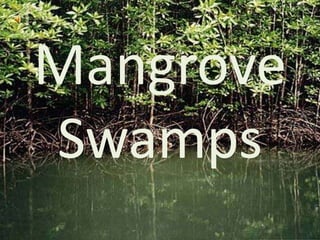
Mangrove swamps
- 2. What are they? Are area’s of diverse tree’s and shrubs which grow in saline conditions around the coast. Many different types of tree’s and shrubs can make up the mangrove They form a characteristic saline woodland or shrubland habitat called ‘The mangrove swamp’
- 3. Where are they? Located in: Africa (Kenya, Tanzania and Madagascar) The America’s (Costa Rica) Caribbean islands Asia New Zealand and Australia
- 5. Environment Benefits Mangroves provide food, nesting and nursery areas for many animals which include: -220 fish species, -24 reptile and amphibian species -18 mammal species and -181 bird species
- 6. Environmental benefits continueeeyed By acting as wave breaks they stop coastal erosion and protect the shoreline from tsunamis and hurricanes. They also trap sediment and debris which improves the water quality of tidal rivers. Mangrove’s can also trap toxins that have been released into the water
- 7. Social benefits Mangrove Swamps offer mankind many benefits, including, but not limited to Mangroves are extremely important for supporting the fisheries industry which generates a high amount of revenue. Mangroves are a rich source of timber which can be harvested on a sustainable basis. Other mangrove products are also used, including the harvesting of mangrove plants for a wide range of medicinal uses. Some mangrove animals, like the proboscis monkeys of Borneo with their unusual noses, are tourist attractions and thus generate income.
- 8. Why are they at risk? Mangrove forests are lost when they are torn up, filled in and dug under for other purposes such as agriculture, aquaculture and other development activities. People often wrongly perceive Mangroves as unsightly and want them removed so as to enhance the environment. Mangroves then often become garbage dumps. Pollution adversely affects Mangrove Swamps. Pollution degrades the quality of the plant life and the water in the swamp, which in turn adversely affects the insects and animals that also live there. The roots of the mangroves can become easily clogged with man-made sediments and petroleum as well as from other pollution. Mangrove Swamps often are mistakenly thought to be breeding grounds for mosquitoes and either flooded with insecticides or filled in with dirt hoping to prevent a mosquito infestation.. Pruned mangroves grow fewer prop roots and fruit and this in turn provides a lower quality habitat. Pruning also diminishes shoreline protection and reduces the number of bird species using this habitat.
- 9. Strategies to protect them Every time another house is built; a bigger shopping mall goes up; or another parking lot is paved, wildlife habitat is lost! Become aware of all new building proposals in your area. Voice your disapproval of any that threaten wildlife habitat. You can do this in a number of ways, two of which are: 1) attend town meetings and clearly and respectfully voice your objections and 2) vote out of office those politicians who do not support the environment or wildlife. Learn all you can about the importance of Mangrove Swamps. Teach others what you have learned. Be sure to impress upon others how important Mangrove Swamps are to biodiversity on Earth! Help others see the real beauty of this unique habitat area. Buying organically grown vegetables, flour or meat reduces the use of chemical fertilizers, pesticides and herbicides, which, in turn lessens the pollution killing the Mangrove Swamps. Use environmentally-friendly cleaning products to avoid polluting water. If your local market does not carry these, ask the manager to start. Dispose of oils, chemicals and old batteries at your local collection site. This will ensure that they are disposed of properly and will not end up in a Mangrove Swamp, if you live near one, or in your local river or stream that eventually will pass through a wetland area on its way to the sea.